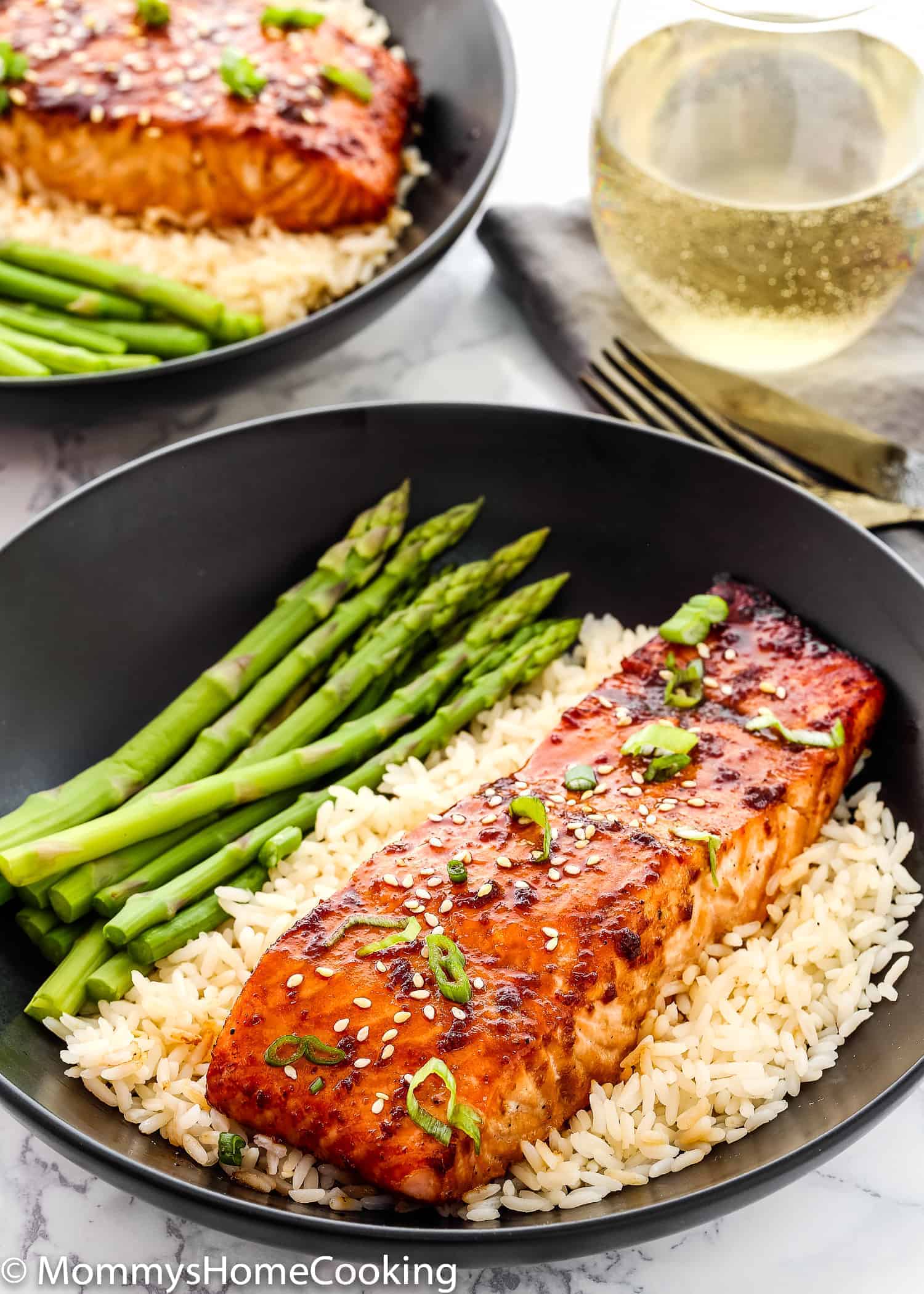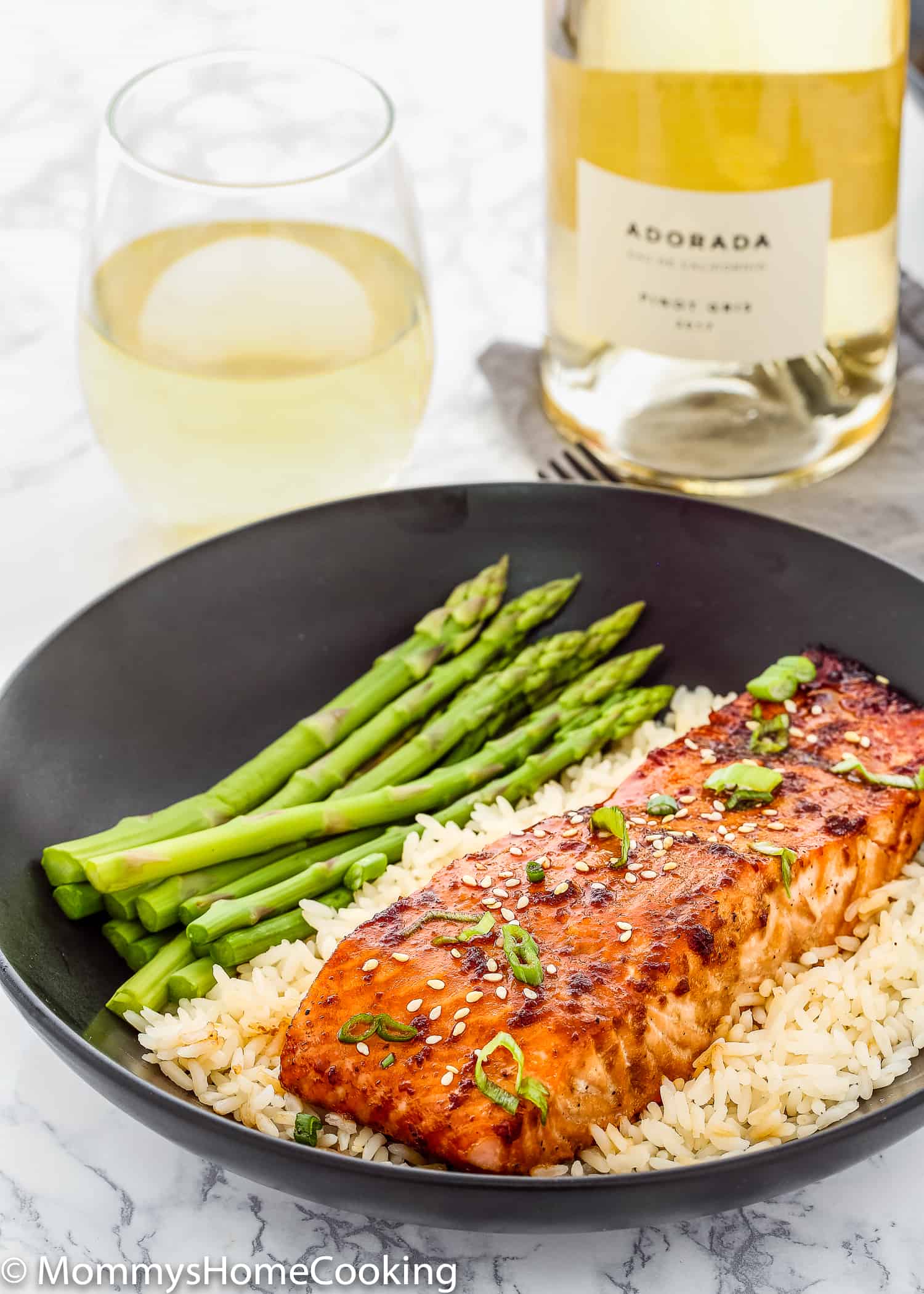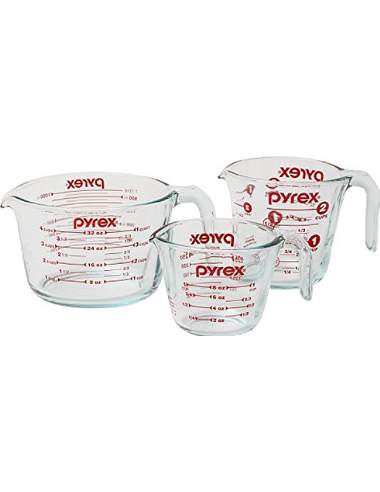This Easy Teriyaki Salmon is tender, flaky, and packed with amazing flavor. Ready in less than 30 minutes and requires only a few ingredients.

Quick & Easy Teriyaki Salmon Recipe
I love to cook salmon for dinner because it’s easy to make and super flavorful.
In my opinion, salmon makes for a perfect weeknight meal for when you want something quick but still delicious. And when it’s dressed in the most amazing teriyaki sauce you will end up with an out-of-this-world delicious dinner!
This Easy Teriyaki Salmon is savory, sweet, and full of flavor in every bite. Such an easy and wonderful meal to come home to after a busy day.
Our family, including my picky eaters, just couldn’t seem to get enough of this delicious Teriyaki Salmon! Perfect weeknight meal but fancy enough for special occasions too.
This is going to be a recipe that you make again and again!

Ingredients You’ll Need
- Skinless salmon fillets
- Green onion
- Sesame seeds
For the teriyaki sauce:
- Low sodium soy sauce
- Rice vinegar
- Garlic, minced
- Freshly grated ginger
- Canola oil
- Brown sugar
- Black pepper
HOW TO MAKE TERIYAKI SALMON
1 – All it starts making the teriyaki sauce.
2 – Then marinade the salmon for 15-20 minutes.

3 – Finally, bake the salmon until flaky perfection.

Frequently Asked Questions
How long should I marinate salmon?
Salmon only needs to be marinated for about 15–30 minutes.
How do I know when the salmon is done?
The salmon is done when it reaches an internal temperature of 145° F (measured with a cooking thermometer in the thickest part of the filet). If you don’t have a thermometer, you’ll know when the salmon is done when easily flaked: check the doneness of your salmon with a fork. When the salmon flakes easily with a fork, it’s ready.
Can I make this recipe with another kind of fish?
Yes, you can! Just make sure to adjust cooking time accordingly.
Can I make this Teriyaki Salmon recipe Whole30 complaint?
Yes, you can! Substitute soy sauce for coconut aminos, canola oil for avocado oil, and brown sugar for 1 tablespoon of date paste.

What wine goes well with salmon?
Since salmon is a rich oily fish, it pairs wonderfully with full-bodied white wines, such as Chardonnay, White Burgundy, White Pinot Noir, or Pinot Gris.
To pair a five-star meal like this all we needed was a glass of wine, so we decided to open a bottle of Adorada Pinot Gris, which was a perfect match. This wine is amazing! It was subtly sweet and refreshing.

HOW TO SERVE EASY TERIYAKI SALMON
Serve this Easy Teriyaki Salmon over some plain white rice with a side of steamed vegetables like asparagus or broccoli.
LOOKING FOR MORE SALMON RECIPES?
- Cranberry Honey Glazed Salmon
- Sheet Pan Mustard Salmon Dinner
- Easy Eggless Salmon Patties
- Salmon with Roasted Tomatoes and Corn
- Skinny Glazed Salmon

Easy Teriyaki Salmon
Ingredients
- 4 skinless salmon fillets (about 6-8 oz each)
- 1 green onion, sliced (optional)
- 1 teaspoon sesame seeds, for garnishing (optional)
Teriyaki Sauce:
- 3/4 cup low sodium soy sauce
- 1/3 cup rice vinegar
- 3 cloves garlic, minced
- 3 teaspoons fresh grated ginger
- 3 tablespoons canola oil
- 4 1/2 tablespoons brown sugar
- 1/4 teaspoon black pepper
Instructions
- Combine all the sauce ingredients in a medium bowl and stir until brown sugar is dissolved.
- Place salmon fillets in a deep baking dish, or a big bowl. Pour the sauce over the salmon, cover with plastic wrap, and let marinate in the refrigerator for 15 – 20 minutes.
- Preheat oven to 400˚F. Line a big baking sheet with foil for easy clean up later.
- Transfer salmon fillets to the prepared baking sheet. Reserve the marinade.
- Bake for 12-15 min or until salmon is flaky and cooked through. Bake times may vary depending on the thickness of salmon. You'll know when the salmon is done when easily flaked: check the doneness of your salmon with a fork. When the salmon flakes easily with a fork, it's ready, or when it reaches 145º F internally.
- While salmon is baking, place the remaining marinade to a small saucepan and bring to a boil then reduce heat to low and simmer, stirring occasionally, until slightly thickened, about 5-8 minutes. NOTE: If you want to thick the sauce even more mix 1 teaspoon of water + 1 teaspoon of cornstarch and add it to the sauce. Remove from heat and reserve to serve with the salmon.
- When the salmon is done, remove from oven and brush each fillet with more sauce. Sprinkle with green onions and sesame seed, if desired. Serve with rice and steam veggies.
- Cranberry Honey Glazed Salmon
- Sheet Pan Mustard Salmon Dinner
- Easy Eggless Salmon Patties
- Salmon with Roasted Tomatoes and Corn
- Skinny Glazed Salmon
Nutrition

Love what you see? Subscribe to Mommy’s Home Cooking so you’ll never miss a recipe! Follow along on Instagram, Pinterest, Twitter, and Facebook for more fun!
?When you make this recipe, be sure to snap a photo and hashtag it #MommysHomeCooking. I’d love to see what you cook!
* This post contains affiliate links, thank you for the support in keeping Mommy’s Home Cooking up and running!
This post is sponsored by Adorada Wines. The following content is intended for readers who are 21 or older.
Originally posted March 2018, post content edited to add more helpful information, no change to the recipe in June 2020.




